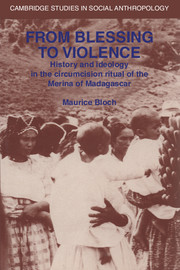Book contents
- Frontmatter
- Contents
- Preface
- 1 The social determination of ritual
- 2 Background politico-religious history of the Merina, 1770–1970
- 3 Background to Merina social organisation and religion
- 4 Description and preliminary analysis of a circumcision ritual
- 5 The symbolism of circumcision
- 6 The myth of the origin of circumcision
- 7 The history of the circumcision
- 8 The circumcision ritual in history: towards a theory of the transformation of ideology
- Notes
- References
- Index
- CAMBRIDGE STUDIES IN SOCIAL ANTHROPOLOGY
7 - The history of the circumcision
Published online by Cambridge University Press: 05 June 2012
- Frontmatter
- Contents
- Preface
- 1 The social determination of ritual
- 2 Background politico-religious history of the Merina, 1770–1970
- 3 Background to Merina social organisation and religion
- 4 Description and preliminary analysis of a circumcision ritual
- 5 The symbolism of circumcision
- 6 The myth of the origin of circumcision
- 7 The history of the circumcision
- 8 The circumcision ritual in history: towards a theory of the transformation of ideology
- Notes
- References
- Index
- CAMBRIDGE STUDIES IN SOCIAL ANTHROPOLOGY
Summary
If the myth of the origin of circumcision discussed in the preceding chapter is not of historical significance as regards the story it purports to tell, it remains of historical value by implication. It makes it clear that, at the time when the myth was collected, the details of the ritual were largely similar to what they are today.
From 1793 to 1825
Our earliest genuinely historical source, however, is a statement of the laws concerning circumcision. Like the myth, these laws are also found in Callet's collection of traditions, oral histories and manuscripts entitled Tantaran ny Andriana. These laws do not specify in detail how the ritual should be carried out and seem to take this side of things for granted; rather, they specify when the ritual should take place and what taxes should be paid. The laws take the form of a royal speech, as do all Merina laws. The speech is reported as spoken by Andrianampoinimerina and probably dates back to the period between 1793 (when Andrianampoinimerina installed himself in Tananarive) and the time of his death and the succession of Radama I, probably 1810. It is, however, possible that the so-called laws of Andrianampoinimerina are laws of Radama I, which were described as being the work of his father to give them greater legitimacy. This phenomenon is quite common in Merina tradition, and it has been described by Délivré as ‘ascending anachronism’ (Délivré 1974, pp. 177, 199).
- Type
- Chapter
- Information
- From Blessing to ViolenceHistory and Ideology in the Circumcision Ritual of the Merina, pp. 113 - 156Publisher: Cambridge University PressPrint publication year: 1986
- 1
- Cited by



